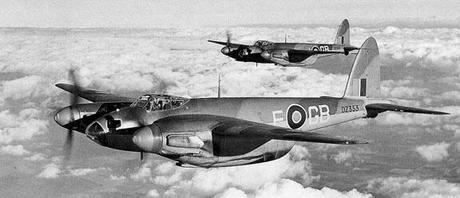[Crossposted from CharlesMcCain.com]
From my novel, An Honorable German:
Behind him the Beau Sejour disintegrated, its wooden splinters cutting down the sentries and anyone else close by. There had been no air raid siren, no warning whatsoever, but this was hardly remarkable anymore. The RAF’s high-altitude Mosquito bombers were made entirely of wood and German radar often failed to pick them up.
The de Havilland Mosquito, one of the most successful aircraft of World War Two, had an airframe composed entirely of wood. Wood!? In World War Two? As odd as it seems the answer is ‘yes’. The fuselage of the Mosquito was made of balsa wood pressed between two layers of cedar plywood. The rest of the airframe was made of spruce, with plywood covering. The wing was built in one piece, and attached to the lower side of the fuselage structure. The aircraft wasn’t very big: 41 feet long with a wingspan of 54 feet.

The “Timber Terror” out-performed almost every other aircraft in World War Two. It also functioned equally well as a high altitude night bomber, night fighter, U-boat hunter, photo reconnaissance plane, daytime low altitude bomber, and daytime fighter. No wonder its other nickname was the “Wooden Wonder.” The Oxford Dictionary of National Biography says the de Havilland Mosquito is thought to be the most versatile warplane ever built. I think anyone who studies the plane would agree.
The Mosquito annoyed the Germans to no end. In 1943, said Reichsmarshal Göring, the drug-addicted, foul toad of a man who was C-in-C of the Luftwaffe:
It makes me furious when I see the Mosquito. I turn green and yellow with envy. The British, who can afford aluminum better than we can, knock together a beautiful wooden aircraft that every piano factory over there is building, and they give it a speed which they have now increased yet again. What do you make of that? There is nothing the British do not have. They have the geniuses and we have the nincompoops. After the war is over I’m going to buy a British radio set – then at least I’ll own something that has always worked.
– as cited in “Pathfinder Aircraft” published by the RAF
The aircraft was the brainchild of Geoffrey de Havilland, the design and industrial genius behind the de Havilland Aircraft Company in Great Britain. He was a first cousin to actresses Olivia de Havilland and Joan Fontaine – who were sisters. Their father and Geoffrey’s father were half-brothers.

The prototype made its first flight in late 1940 and was put through RAF testing in February of 1941. It out-performed the Supermarine Spitfire in the two critical areas de Havilland had envisioned: speed and altitude. The Mosquito tested out at a top speed of 392 mph (631 km/h) at 22,000 ft (6,700 m) altitude, compared to a top speed of 360 mph (579 km/h) at 19,500 ft (6,000 m) for the Spitfire. Quite an accomplishment.
By comparison, the US F-16 Falcon fighter jet, which is on active operations in the US and 28 other countries around the world has a a top speed of 1,500 mph, (2,410 km/h) at high altitude, its maximum altitude being 60,000 feet (18,000 m).

During his long life (1882 to 1965 [45 years ago as of May 21st] – he died at age 82 and had continued to fly until he was 70), Geoffrey de Havilland set many records, invented many things, lived large but he will ever be remembered for the incredible de Havilland Mosquito which was so important to Allied victory. I wish I could have met him once.
